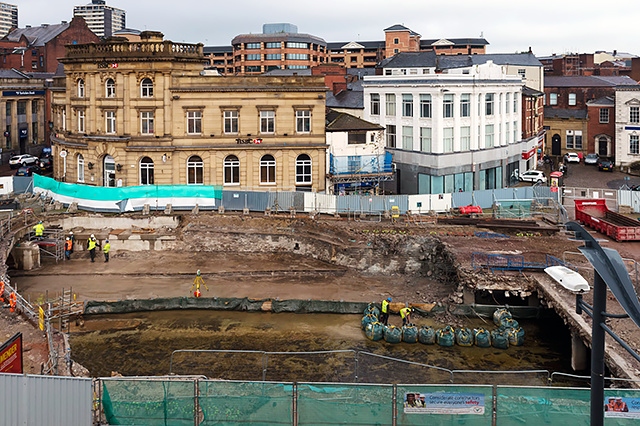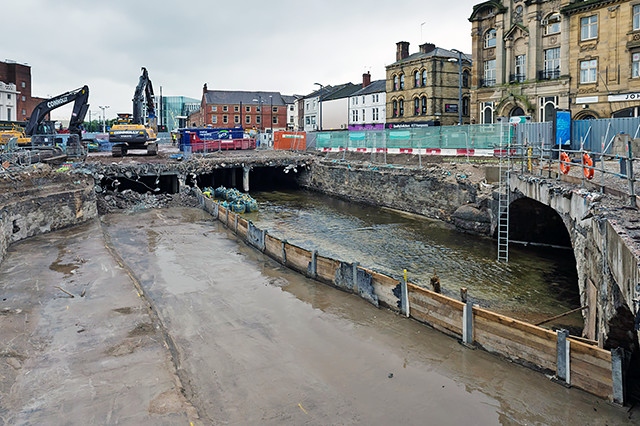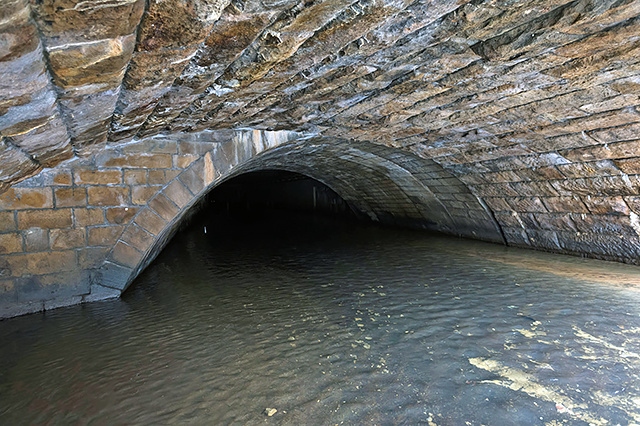Progress on uncovering the River Roch continues apace
Date published: 08 August 2015

Uncovering the River Roch in Rochdale Town Centre - an aerial view from Bar 5
Scroll down for Video
The work to uncover the River Roch in Rochdale Town Centre is making good progress.
The project is uncovering two sections of the River Roch, which were hidden beneath Rochdale town centre. One of these sections lies underneath The Butts in front of HSBC and the other section is outside Barclays on The Esplanade.
This project will also expose the river’s historic bridge, parts of which can be traced back to the medieval period.
The bridge and sections of river being exposed were covered over in the Victorian period and have been hidden from public view for more than a century.
Revealing the Roch will allow people to access and enjoy views to and from the bridge again.
Photos
Above is an aerial view from Bar 5.

There are three distinct sections here. The section on the far left will be built on to provide a footpath outside HSBC. The two sections on the right, which are divided in the middle by a wooden fence, will all be river.

The bridge you can see from the upstream side of the river (in front of HSBC). The section at the front is the 1821 section of bridge, which is built in the Regency style, and the section further in is the 1787 (Georgian) section. The outer section, although the newest, actually looks rougher and older than the earlier parts. This is because different building methods and architectural styles were being used. Earlier sections of the bridge have pointed rather than rounded arches and the stone looks much smoother as it was treated and dressed more than in later periods.

The outer section of the bridge close to HSBC (1821, built in the Regency style). This concrete was placed on the bridge as part of earlier repair work. Specialist stonemasons working on the bridge throughout the summer will remove this and repair the stone below using millstone grit, the same stone which was used to build the bridge originally.

This is another view of the section outside HSBC. The river walls (which date from the 19th century) will be built up and stonemasons will clean and repair the stone.
The next stages will be to complete the demolition on the upstream side while the stonemasons continue their repair work. There will be some work done on the bridge.
In autumn, work to reopen the downstream section in front of Barclays will start as will public realm improvement work, which will see the rest of The Butts repaved in York Stone, the stone which is used on Yorkshire Street.
History
The earliest part of bridge is likely to have existed by the 14th century. Records suggest it was built using free stone which was collected from Scouthead Moor. Locals used it to transport goods like wool and cotton over the river on horses and oxon, so they could travel over to Yorkshire to buy and sell goods. Before this, people had mainly used stepping stones to cross the river.
As well as examining the bridge itself, historians use other evidence to establish how old it is. This includes documentary evidence from the time. One document from 1324 refers to ‘John of the Brig’, which suggests a person who was associated with the bridge existed at that time. Using different pieces of evidence to determine the exact age of the bridge is important as it helps restore the bridge in the most sympathetic way, ensuring it is as in keeping with its original condition as possible.
The original medieval bridge has been widened over the centuries, so the bridge we have now tells the story of Rochdale through the ages. The bridge was initially widened in 1667 (the restoration period) after it got damaged in a flood. In 1787, the Georgian period, the bridge was widened again to accommodate the larger carriages which were needed in a growing town. And during the Regency period (1821), the bridge was widened again following an accident which occurred on 8 November 1820. Too many people had gathered on the bridge to watch the bull baiting which was taking place on the bed of the river below and part of the bridge collapsed. 11 people lost their lives and bull baits were never held on the river again.
In the early 1900s the bridge and river started to disappear from view. According to an ordnance survey map of the period, by 1910, a tram shelter was present on South Parade. It is likely that the bridge and river was covered over, so the space on the Butts, which had previously been, could be used and an area where trams could manoeuvre.
Video
Uncovering the River Roch in Rochdale Town Centre
©RMBC
Do you have a story for us?
Let us know by emailing news@rochdaleonline.co.uk
All contact will be treated in confidence.
Most Viewed News Stories
- 1Newhey's Char Steakhouse and Bank Chamber close with immediate effect
- 2Two men arrested after police chase ends up in Middleton river
- 3Six men arrested in Rochdale child exploitation investigation
- 4Man charged in connection with assault on Christmas Eve in Sudden
- 5Six men charged in connection with child exploitation investigation
To contact the Rochdale Online news desk, email news@rochdaleonline.co.uk or visit our news submission page.
To get the latest news on your desktop or mobile, follow Rochdale Online on Twitter and Facebook.


